A very spanish Expression
Thursday, August 30, 2012
Last night, in the stadium "Santiago Bernabeu" (Madrid, Spain) , has been played the second football match of the tournament named "Supercopa de España", among Real Madrid and F.C. Barcelona.Although I do not want to talk about footbal, but a very used spanish expression.
I could not watch the match, but it does not matter, because I am not a follower of any team, except the team of Spain.However, I could listen the last minutes of this match through the radio.On the radio they were talking about the new signing in the Real Madrid: Luka Modric (a player from Croatia).This was his first match in the Real Madrid, --although he has only played for five minutes-- and just last night he did what that expression says. because the Real Madrid won the match.
The announcers were commenting the new arrival of Modric and his good luck, being abble to play this important match. The expression is this one:
Llegar y besar el Santo = To come and kiss the Saint
This expresion means to reach the maximum level of good luck.For example, when you find a free place to leave your car quickly, in a public street, while another drivers can not get the same good luck.
Also it has had grace, because I was watching the end of the match through my computer and, just when the goalkeeper of the Real Madrid, Iker Casillas, gave the Cup to Modric, in order that he could lift it, the image stood.I do not know what happened, but it was a curious thing --because I was thinking of this post, about that expression and Modric as a good example, since some minutes before--.
In this case, talking about Modric, we could say: "Ha sido: llegar y besar el Santo" = "It has been: come and kiss the Saint".
This is Luka Modric:

Kind regards,
Luis.
Sponsored by Costaluz Lawyers.
Click down here:
.jpg)
 0
Like
Published at 4:52 AM Comments (0)
0
Like
Published at 4:52 AM Comments (0)
Another Spanish sayings and proverbs, 38
Wednesday, August 29, 2012
Today I wanted to show you a saying so used in Spain; however, i have found another spanish saying that I have never listened.
It is a saying that I really liked, because it has a great message and also it seems very funny.
This is the saying:
A la ira y al enfado, darles vado = To rage and anger, give ford.
It means: to dodge them skillfully.There is a funny but deep story about a Director of Orchestra, Toscanini, who a day, in a moment of anger, he threw his watch out against his musicians.The silence appeared; but some days after, this illustrious Director received his watch, already repaired, and another one, cheesy, that said: "This one only for trials.".
Note: Vado: Ford means in public any change of structure in sidewalk and curb intended solely to facilitate vehicle access to premises within the estates against which it is practiced.
Kind regards,
Luis
Sponsored by Costaluz Lawyers
Click down here:
.jpg)
 0
Like
Published at 6:27 PM Comments (0)
0
Like
Published at 6:27 PM Comments (0)
Record of cruise travelers in Seville (Spain)
Thursday, August 23, 2012
Last night, arrived to the Port of Seville, the largest cruise ship of which have arrived to this town in the south of Spain, till now.Inside it, there are more than one thousand people.
The ship Azamara Journey, a luxury cruise shipping group of Royal Caribbean Cruise from Lisbon, has docked at Dock of las Delicias(Delights). Passengers will stay two days in the city before leaving for Gibraltar.

The Port of Seville reports that this is the largest number of passengers has reached the dock of las Delicias. The cruise lasts 13 days and 12 nights, came out on the 20th from Lisbon and it aims to reach the next September 1, to Montecarlo. The rates per passenger range between 2.800 and 4.700 euros.
Given this arrival, the Seville City Council will launch the first Cruises Cecop, which will coordinate in the port all the services of police, taxis, clean urban, transport and offering "all necessary guarantees to cruises coming to town and a commitment to quality in the services offered to them ", as detailed from the Consistory.
But it shall not be the only one cruise docked in Seville. In October is also expected the Azamara Quest, belonging to the same company group Norwegian-American.
For its part, the Azamara Journey is a boat built in 2000, with a length of 180 meters and 28,3 meters wide, with eleven decks and 42 suites, swimming pools, restaurants and golf simulators, that displaces 30.277 tons. The cruise is consigned by Suardiaz Steamship Company.
In this framework, the Mayor of Seville, Juan Ignacio Zoido, has reviewed this arrival, warning you to improve port and access to the river (Guadalquivir) so that it "is not something sporadic, but normal." He said that it is "very good" that Seville joins the large cruise tourism and should be "common" in all the cruise lines, "which are both the Mediterranean and the Atlantic."
I hope that it is another way of knowing such wonderful things of Andalussia.
By the way of this news about the cruise in Seville, I want to remind you that in 22 January 2009, I put a post about Seville, with pictures which I made in February 2008.But, a short time after, I knew that Eye On Spain had a technical problem and cause of it, some of my pictures disappeared.Well, the days and months passed and I forgot to recover the lost pictures; that is the truth and I want to beg your pardon, to all of you but especially to Donald, who told me that "the most of the pictures were broken" and I never answered him. I hope that he can see this post, in order that he can recover those pictures as he deserves.
I want to carify one thing: I have added some new pictures.
Here you have the link to that post.I hope that you enjoy it and thanks for your understanding:
http://www.eyeonspain.com/blogs/luislopezcortijo/1119/sevilla--a-wonder.aspx
Kind regards,
Luis.
Sponsored by Costaluz Lawyers
Click down here:
.jpg)
 0
Like
Published at 2:05 AM Comments (0)
0
Like
Published at 2:05 AM Comments (0)
A spanish lady very supportive
Wednesday, August 22, 2012
Yesterday night, I listened, on the radio, to a spanish lady, who explained that one day a story struck her: she saw a mother with her very young daughter, searching in the trash. Therefore, she thought she had to do something for many women who had a few money or even none.Then, she started to make several necklaces and earrings, in order to sell them and give the money to those women.
She said she has a website, where you can see and buy her jewels, which are not expensive.This is the website:
http://www.joyasameli.es
Her name is Paquita Vizcaino and she said the following, at the begining of her website:
“Create is excitement and passion, also my job, it is one of the most rewarding things in life. Materializing dreams has magic, but certainly the most rewarding is to help others.
I passed this jewelry collection in time cause the social urgency, that unfortunately exists. People who know that I always respond to requests for help, I have asked and I answered. I hope that you also should do.
Unreduced benefit Jewels collection of Solidarity is to help people in distress. You will have timely information on the videos that I will upload in paquitavizcaino Youtube channel”.
After that, you can see the images of the jewels and, below all, you can read this one:
JEWELRY AMELI is the online store of jewelry designed by Paquita Vizcaino. Unreduced benefit Jewels collection of Solidarity is to help people in distress.
In jewelry Ameli, you will find an exclusive design jewelery made with passion and care. Silver rings, silver pendants, silver anklets, silver engagement rings, silver earrings, silver crosses, silver bracelets, silver necklaces, silver necklaces, silver sets, silver chains, silver brooches, silver designer jewelry, gemstone jewelry, necklaces woman, girl necklaces, rings, earrings, belt jewel jet jewelry, agate jewelry, pearl necklaces, silver jewelry design, the best designs in jewelry silver, fashion silver jewelry silver news, silver accessories.
Made with the following gems:
Agate, amber, amethyst, aventurine, chalcedony, apple coral, blue coral, white coral, red coral, bamboo coral, carnelian, rose quartz, rutilated quartz, garnet, jade, jasper, labradorite, lapis lazuli, malachite, mother of pearl, tiger eye porthole, onyx, opal, moonstone, sun stone, ruby, serpentine, turquoise, pearls, cultured pearls, blue agate, Botswana agate, Indian agate, apatite, calcite, shell, crystal, Czech glass, ebony, glass Swarovski, quartz, rose quartz, green quartz, spinel, agate fire, yellow agate, aquamarine, amethyst African amazonite, ametrine, andalusite, blue aventurine, aventurine gold, green aventurine, Majorica pearls, fluorite, jet, azurite, beryl, golden beryl, red beryl, chalcedony, carnelian, charoita, caroíta, zircon, citrine, coral, corundum, chrysocolla, quartz, smoky quartz, cat's eye quartz, rutile quartz, diamond, emerald, star of night, red jasper, obsididana, snowflake obsidian, obsidian, golden, freshwater pearls, cat's eye, hawk eye, olivine, howlite, lava, lava-colored, pearl, mica, mokaita, black onyx, yellow onyx, opal, peridot, pearl river , silver, rhodonite, ruby, rutile, sodalite, tanzanite, topaz, tourmaline, blue tourmaline, black tourmaline, pink tourmaline, turquoise, sapphire, pyrite, porcelain, sodalite, turquenita, Xilópalo, abalone, prinita, rhodonite.
Under the little images of the jewels, you can see the way of payment and it says:
“Envios gratis, pedido minimo 50 Euros” and it means:
“Free shipping, mínimum order 50 Euros”.
I hope that you like the collection and above all the motivation that Paquita Vizcaino has had for it.
Enjoy it and help her, if you can do it !.
Thank you and kind regards,
Luis.
Sponsored by Costaluz Lawyers.
Click down here:
.jpg)
 0
Like
Published at 1:40 AM Comments (0)
0
Like
Published at 1:40 AM Comments (0)
A discreet Spanish project for a social aid
Tuesday, August 21, 2012
The town of Cartaya (Huelva) will have, from next September, a social dining that will be the first of which will Andalusia home service, so that can be used "with discretion" by people who do not want to go in person to their facilities daily.

"Cartaya", Huelva, South-West of Spain, by Manuel M. Ramos, at flickr.com
One idea that has detailed to Efe the oldest brother of the Brotherhood of Consolation of the locality, Manuel Perez, who noted that, with this innovation, they will make people who "have shame to be seen in this type of establishment may use the service rendered without any problem”, so as not to stop providing the service to anyone who needs it.
For this one, the room will have a distribution service orders by opening regular hours each day, an idea that once you have applied have found that many people come to dispense with the services "to the shame they have to be seen in the soup kitchens".
This is an initiative that the brotherhood developed in collaboration with the NGO Foundation for North-South Cooperation (Fecons), which manages the soup kitchen of the nearby town of Lepe, and whose experience in this field has moved to his new project .
Kind regards,
Luis.
Sponsored by Costaluz Lawyers.
Click down here:
.jpg)
 0
Like
Published at 1:27 PM Comments (0)
0
Like
Published at 1:27 PM Comments (0)
The Solar Energy in Spain
Friday, August 17, 2012
These days, there is a debate, in Spain, about Solar Energy.Some scientists are against this natural energy, because they say that it is so expensive; but another scientists say that it is not so exactly, because, although it is true that it is not a cheap energy, at the end, it is cheaper than another energies like Nuclear Energy.
In that sense, this morning I have listened, on the radio, an interview to the President of the Asociation of Producers of Renewable Energies and he said that people need to know well the trouble.The scientists who are against Solar Energy say that the Spanish State has a deficit around 24.000 million of Euros; but this President says that it is not exactly cause of Solar Energy, but a debt that the Spanish State has with the companies of Electric Energy.A great diference among Nuclear Enegy and Solar Energy is that the first one leaves residue, however the second one does not leave anything.Then, we can be proud, knowing that Spain is the fourth country in Solar Enery, all over the World.

"Colores de Abril II", La Puebla de Almoradiel (toledo), Spain, by Hortolano, at flickr.com
Solar Energy is a clean one.Also, it is not gotten from the land.Also it creates jobs and it leaves the money in Spain.
Now, Spain exports the 80 per cent of the Solar Energy to Germany.
The Spanish government has pledged to produce 12% of energy from renewables by 2010. The more than 3600 megawatts (MW) of photovoltaic plants in Spain and in 2009 produced 1.9% of electricity consumed. In 2004, the Spanish government removed economic barriers to connecting renewables to the grid. Royal Decree 436/2004 levels the playing field for large scale production of solar thermal and photovoltaic and warrant sale (raw or feed-in tariffs in English).
On June 1, 2007, came into force on Royal Decree 661/2007 of 25 May, which regulates the activity of electricity production in special regime, which maintains a system similar to those established by Royal Decree 436 / 2004 to March 12, in which the owner of the facility may choose to sell their energy at a rate regulated shop for all planning periods, or sell the energy directly in the daily market in the futures market or through a bilateral contract in this case the trading price on the market plus a premium. In the latter case, they introduced a novelty for certain technologies, lower and upper limits for the sum of the daily hourly market price plus a premium of reference, so that the premium to be charged in every hour, can be bounded in terms of these values. The new system protects the promoter when the income from the market price were too low, and eliminates the premium when the market price is high enough to ensure recovery of costs, eliminating irrationalities in the remuneration of technologies, whose costs are not are directly linked to oil prices in the international markets.
Since the late 2000, the Solar installed capacity has risen to 3.479 MW, in 2009, and to cover 2.6% of the electricity demand in the same year.
I agree with the bet for the Solar Energy.
Kind regards,
Luis.
Sponsored by Costaluz Lawyers
Click down here:
.jpg)
 0
Like
Published at 2:13 PM Comments (0)
0
Like
Published at 2:13 PM Comments (0)
A spanish saying about July
Friday, August 17, 2012
Yesterday, I was watching on tv a contest, where they asked the contestants an question, that it was a spanish saying and it was this one:
Quien trabaja en Julio, trabaja con orgullo.
It means this one:
Who works in July, works with proud.
The contestants must to guess the end of the sentence and it was: "....con orgullo" ("....with proud").
This saying means that July is a good month --if weather is good--, because farmers reap the harvest.

"Por un 2011 saturado de buenos momentos!/ For a 2011 saturated with good moments", by Adry, at flickr.com
Kind regards,
Luis.
Sponsored by: Costaluz Lawyers
Click down here:
.jpg)
 0
Like
Published at 2:44 AM Comments (0)
0
Like
Published at 2:44 AM Comments (0)
Historical excavations in Spain
Thursday, August 16, 2012
A group of 150 archaeologists, paleontologists, geologists and surveyors work for 40 days in the fields of Fig Tree Glade in the suburb of Pinilla del Valle, to try to find what could be the first tomb of the Iberian Peninsula Neanderthal and the most southerly in Europe.
.jpg)
The work, which began yesterday and are part of the eleventh season of excavations at the Regional Archaeological Museum (MAR) --under the Ministry of Culture and Sport--, will be performed in the only place in the world that brings together three Neanderthal sites as close together other: the Navalmaíllo coat and the caves of the Good Paint and Off-Deck. This area, called 'glades', was declared in 2005 a Cultural (BIC) in the category of archeology and paleontology by the Community of Madrid.
It is the Cave Des-Deck which raises more expectations from the group of experts, as during the campaign of 2011 found four baby teeth of the species Homo neanderthalensis that could have belonged to a girl. The researchers named it The girl Lozoya Valley in honor of the river that bathes the valley. In this new campaign work will focus on verifying that it was an intentional enterramienro, which would make him the first Neanderthal grave of the peninsula and most meriodional in Europe.
During the last campaign were also found in this cave symbolic signs that make it one of the most attractive sites of world prehistory, because there is currently much debate in the scientific community about the symbolic capabilities of Neanderthals.
The excavations were conducted under the direction and co-director of the Atapuerca paleoanthropologist Juan Luis Arsuaga; the director of the Regional Archaeological Museum of Madrid, Enrique Baquedano; and the geologist and deputy director of the National Research Center on Human Evolution, Alfredo Perez-Gonzalez. For the deposits will also students from different disciplines related to archeology and paleontology.
Spain is rich in archaeological sites; so, I hope that Juan Luis Arzuaga and his team can finish this such an interesting and important project for Spain.
Best regards,
Luis.
Sponsored by Costaluz Lawyers.
Click down here:
.jpg)
 0
Like
Published at 2:05 PM Comments (0)
0
Like
Published at 2:05 PM Comments (0)
Stop fire in Spain!
Tuesday, August 14, 2012
Yesterday night, I could listen on the radio to the wonderful Singer of Couplets, Ana María Ramos; she is considered “The Queen of the Couplet”, in Spain.
In the interview, they talked about fires, because now, unfortunately, Spain is suffering a terrible summer of forest fires.Then, Olga said that, some years ago, she singed a song that talked about fires.This is the song; please click down here:
http://youtu.be/W3Tn0mc2cfE
That interview made me feel bad, thinking about many forest burning, many firefighters injured or even dead and so…many families suffering, the most of all cases are arson. Then, I was thinking about the idea of keeping forests clen; in this sense, I think that Government of Spain has the opportunity of hire to unemployed people, in order to clean forests.But, still more……they could plant cypress…..Yes, recently, it has been discovered that cypress tree resist fire; it has been discovered in Spain, after a fire in the East of Spain
.jpg)
"Cypress trees saved in a burned forest", Jérica, among Valencia and Castellón, East of Spain.
When Bernabé Moya, director of the Tree of the County of Valencia, released the image, botanical colleagues rubbed their eyes. A legion of 946 cypress trees thirty feet high had survived unscathed the fire that hit last July for five days, 20.000 hectares of the Valencian town of Andilla. The picture clearly showed a column of 9.000 square meters of trees planted 22 years ago in Jerica, between Valencia and Castellon. All around, a lunar landscape, devastated, she barely remembered the vigorous mountain pine, oak, juniper, gorse bushes and consuming flames. Fire ignored the green plot. The mystery, and what it means, has returned to unleash the debate on forest regeneration. And in it, some experts are in favor of using cypress trees as natural firebreaks and others reject the planting of alien species into native habitat. The unique island of cypresses Andilla identical adverse conditions suffered their neighboring trees: a year of low rainfall and the deadly rule of three 30: more than 30 degrees, less than 30% humidity and winds over 30 mph. Why fire saved 90% of the cypresses? Why are these trees do not spread the flames?. There is no unanimity among scientists about the capacity of this plant to control or stop the fire. Mediterranean Cypress is a hard species, which accumulates few dead branches on the ground and having a layer of mulch (leaves) slim and compact that retains moisture. This would explain, according to the Department of Monumental Trees of the council, why the flames did not penetrate to the lower areas, although the ravine Herbasana was not cleaned in a decade. More remarkable is the behavior in the cups, as Moya. Although the specimens were together, the fire did not advance to the top. Burned only 12 trees (1.26% of total), which prevented the spread of fire. The flames also caused only dehydration of leaves in 10% of the cypresses. In a few months could regenerate. “The trees acted as a fire screen”, Says the botanist. “The titanic cypress resistance has encouraged the possibility of using this species as an ally to fight the flames. A tree to save another. It could be planted strategically between three and 15 lines of cypress trees to reinforce the firewall in remote areas”. Said Moya, who will consider the use of the species in the reforestation of Mount calcined in Andilla. The image of the green island of Jerica has surprised the experts. “ Know that cypress was used as a noise barrier and waterproof membrane to isolate, for example, a road, but did not know its resistance to fire. If so, you could try the tree as a screen for surrounding homes”, Suggests Rafael Serrada, vice president of the Society of Forestry. More skeptical shown his colleague Raul de la Calle, the College of Forestry Engineers: “We need to know what really happened. Cypress is a kind little fuel, but then to prevent burning. There is no tree fireproof”, Says this expert. The draft nor the cypresses Nicolas Lopez, botanical and technical Seo Conservation Birdlife. “ Enter a species is not native is a mistake, alter the ecosystem and harming the rest of the flora”, he says. Lopez added that the cypress also is a species that hinders the spread of fire but also hinders them from growing other trees and plants. “The horajasca of cypress shows a substance which acidifies the soil, similar to the eucalyptus, making it impossible to grow anything underneath, so that the fire has no fuel, and also prevents the tree to burn faster, because it also has a very dense crown”. However, Lee believes, as Serrada, the cypress they can have a good firewall implementation as on developments. “ You can put two rows of these trees would screen and even windbreaks”, abounds. The cypress trees were planted Andilla thanks CypFire European project, which has a budget of 1.3 million and is co-funded by European Union FEDER. The experiment aims to test the tolerance of trees to frost, drought and timber production and pollen. The fire resistance was initially a more. The initiative was developed in 13 research centers in nine countries including Italy, France, Portugal and Turkey. However, unlike these, fire is not razed areas of cypress and the ability of the species to survive the fire was known only by laboratory experiments. Valencia meet next on Sept. 27 about thirty international experts to address the enigma of non-combustible trees. On the table, a question: Why did not burn the cypress?.
Well, I think that this theme is so interesting; do not you think the same…..?.
Kind regards,
Luis.
Sponsored by Costaluz Lawyers
Click down here:
.jpg)
If you could not see my post tittled "A charming hotel in the South of Spain", now you have the opportunity of seeing it:
http://www.eyeonspain.com/blogs/luislopezcortijo/7488/a-charming-hotel-in-the-south-of-spain.aspx
 0
Like
Published at 2:19 PM Comments (2)
0
Like
Published at 2:19 PM Comments (2)
A spanish writer talks about children
Monday, August 13, 2012
These days, in Spain, many people talks about a book.The tittle of the book is: “Todos los niños pueden ser Einstein” and its writer is Fernando Alberca.
Fernando Alberca was born in Cordoba (SouthWest of Spain), in 1966. Bachelor of Arts. He advised the School Board of Asturias. Today also carries a PhD in Psychology and Masters in Neuropsychology and Education.
He has a Master of Management Education Centers, taught by a Center affiliated to the University Complutense of Madrid.
He is School Performance Advisor and Family Relations, Conduct of children and adolescents, as well as stimulation and motivation of intelligence, self-esteem, concentration, memory, study skills and willingness of children and adolescents.
It is also a professor at the School of Education Sacred Heart of Cordoba. Where he teaches Educational Guidance: Family, School and Community, and Violence and Peace Culture School in Primary Education.
He is Professor of Education Institute and Protocol. Honorary Professor of International College of St George, Honorary Member of the Board for the Worth School in West-Sussex (United Kingdom) has been the Lydalls EDUCATIONAL CONSULTANT Oxford Nursery (UK) and Urd Förskolan in Falköping (Sweden) , project coordinator of the Socrates Programme Comenius European Union, with centers in Sweden, UK and Spain, on the teaching of 0 to 6 years. Creator, by the psychiatrist and pediatrician, Francisco Rubio Pool, the FAR method Spelling Easy, with the same title published in the editorial Magisterium Casals.
CO-CREATOR chip system applied to sequential learning in kindergarten and primary education. Plan and Effective Reading, Speaking and Writing at these ages.
He is a COLLABORATOR in different media of radio, press and television, having attended a clinic in Adolescence and direct relationships, over three consecutive seasons. He also starred in a weekly TV show on the Education of Young Children, for two years spent in TeleGijón.
He has been a commentator on the media and current affairs, and educational issues on several television networks, has collaborated with various national media: television, radio, newspapers and magazines and has been interviewed on major programs and media. For example, besides the appearance of reviews in other media and domestic and foreign sites, since the appearance of his book "All children can be Einstein" (several weeks of non-fiction book, best selling in Spain according to Nielsen prestigious list and the top ten in the TOP100 list of Amazon), has been interviewed in the last three months by over 140 media.
Frequent lecturer (over 25 annual conferences) on topics related to warmth, behavior and learning of the baby, child and adolescent, and about love and heartbreak, the marriage and relationships, has published some of his lectures, such as "Tune with the children", "Authority and trust," "to Have and educate" or "self-control" ... She has given lecture series organized by universities, including the Open University in Huesca (Barbastro) for graduates in Psychology, "How to enhance intelligence, memory and will of the baby."
He is married and father of 8 children, aged between 18 and 4 years.
Recently I could listen on radio, a very interesting interview to Fernando, where he is explained the reason of the tittle “…….can be Einstein”.He explained that when Einstein was a child, he was not a good student and he could not get a help from his mother: she said to him that he was an useless.Then, he was so discouraged –although his father was affectionate--.

"Albert Einstein", by MusMs, at flickr.com
Albert Einstein had the mazing opportunity to study out of his town.He went to live with another family and he seemed to be happy.But the real happy and important moment for Albert came when a professor of him invited him to attend his class gratis; it was wonderful for Albert, because that meant an injection of morality, self-esteem; at least, Albert was listened by someone……It was the first time when he was valued, when someone believed in him.He felt affection.That professor begged reviews to Albert; it was very important for him.
Albert´s mother was a violinist; but Albert preferred the piano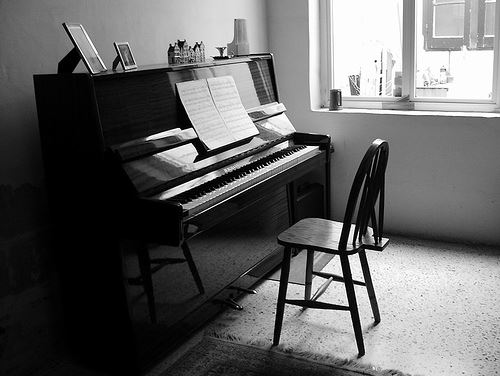
"piano", by MaltaGirl, at flickr.com
Another important idea, in the life of Albert, was the Method; it consisted of using the right hemisphere of the brain –the right hemisphere controls imagination and creativity--.Then, Albert found solutions in the right hemisphere and his wife helped him to formulate mathematically –his wife used the left side of the brain (the left hemisphere), that controls the logic, the Mathematic.
Fernando thinks that intellectual coefficient is useless, that the real important thing is the affection; stimulate the right hemisphere of the brain.
Fernando thinks that a mistake in School is to penalize students.The method used is based on fear of failure, instead of stimulating the imagination.He gives as an example, an exercise that he put to their students.He says: I asked my students: "Eight snails of a basket, leaving three, how many are left?".Usually, everybody should answer 5; but "Eight, 'said one,' because they have left the shell, but not in the basket".It is a response that should not be penalized!.
Fernando also says that It is very important that students learn well to read and write, because it will open them a lot of doors in their lives.As more things they learn reading, as smarter they will be. "Learning is experience, the rest is information," said Einstein. You do not learn things because you are smart: learn things makes you smarter.
“If you really are intelligent, you will be happy”, says Fernado.
Intelligence consists on resolve problems, and the most difficult problem is to be happy.
Fernando says thet it is very important to teach children to overcome obstacles. To see the extraordinary in the ordinary. In every act has consequences. And to truly love.
Fernando thinks that you can love, without expecting anything in return. Nothing brings as much happiness as do the other person happy without you even knowing it.
Then, our children will be less dependent on the fortunes and be able to do what it is proposed.
Kind regards,
Luis.
Sponsored by Costaluz Lawyers
Click down here:
.jpg)
 0
Like
Published at 3:42 PM Comments (0)
0
Like
Published at 3:42 PM Comments (0)
Another Spanish sayings and proverbs, 37
Saturday, August 11, 2012
A la legua:
This is a much used expressionn in Spain.Because the common "legua", in Spain, is similar than more than 5 and half Kms.,it means far and distance.
For example, if you want to express that one idea is soclear, you have to say this sentence: "It was useless; it showed the league that he had no desire to make the least effort".
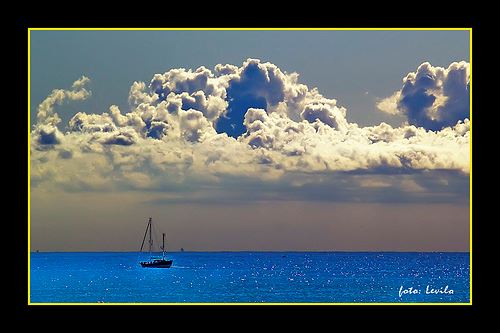
"Horizonte", Leandre-Castellfollit Roca (Gerona), NorthEast of Spain, by levilo, at flickr.com
Kind regards,
Luis.
Sponsored by Costaluz Lawyers
Click down here:
.jpg)
 0
Like
Published at 9:50 PM Comments (0)
0
Like
Published at 9:50 PM Comments (0)
Another Spanish sayings and proverbs, 36
Friday, August 10, 2012
A la chita callando:
It means: with stealth, furtively and with great reserve.Also it is said: A la chitacallando, and it seems that both come from the old game named ·"Los chitos", in which children threw their counters (hopscotch), with extreme care, over the jacks placed in the middle.In order to not to alarm people, you had to go out....A la chita callando. Note: chita is same than chito.
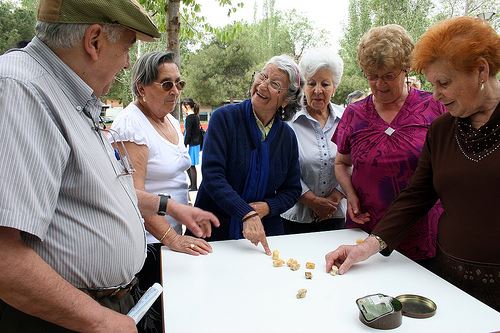
"Taller de Mayores", Fortuna, Madrid, Spain, by Rafael Gomez Montoya, at flickr.com
Kind regards,
Luis.
Sponsored by Costaluzl Lawyers
Click down here:
.jpg)
 0
Like
Published at 1:59 PM Comments (0)
0
Like
Published at 1:59 PM Comments (0)
Tiermas: Another inhabitated village in Spain
Thursday, August 9, 2012
In the North-East of Spain, there is a little village, inhabitated and abandonated; its name is Tiermas.
.JPG)
Current Status: Uninhabited and abandoned.
Altitude: 580 meters.
Distance in miles:
Sos del Rey Catholic: 36 km.
Zaragoza: 155 km.
Madrid: 410 km.
Access: The highway of the Pyrenees in the limits of Zaragoza and Navarre passes by the village. A trail climbs about 400 meters from the road into town. You can only walk (5 minutes).
District: The Jacetania.
Thanks to Jose Garcia Buey, from House Serafina from Los Baños for his cooperation. Magnific and enthusiastic informant in all matters relating to Tiermas. Author of an excellent book called ¨ Tiermas, gateway to the kingdom of Aragon ¨. where an impressive work documenting a journey through the history of Tiermas, detailed home by one to one of those who lived and where left and ends with a small dictionary of words and other indigenous peoples fromTiermas about by problems publishers did not see the light but never available for download on the Internet anyone who wants to read it.
The depopulation of the twentieth century in rural areas With The Historic Town of Tiermas as one of the giants That devoured Them. But It Was Through the tentacles of Government That Engaged In This wonderful town situated on the route of the Camino de Santiago and not was allowed. Because the case of This village not was to Voluntary emigration But A Forced Migration In Many Spanish towns as due to the construction of a swamp. People who never would Have Been deserted if not for the expropriation of fertile farmland That Had the banks of the river tiermenses Aragon. Malthus the Yesa dam construction ended the life of the four districts composed Which Tiermas: The Village, Los Banos, and the homes of Aringo ITS Inhabitants as That by depriving Them of Their Livelihoods Were Involved in an eminent domain to be Also Their homes flooded and Aringo, Los Banos and the people inside the perimeter of the swamp.
Nor saved from the flood was the beautiful medieval bridge that spanned the river channel. Population is of very ancient Tiermas (Thermae was the primitive village close to the hot springs of Roman times). Peter II of Aragon in 1201 to Protect the Population of the frequent wars in those years had found the entrance to the kingdom, Decided to build the new town on high ground where I was also giving it better protected by walls and castle.
After the epoch of wars the people who lived in the village because they had to up and down a very steep cost to have arable land in the plain below Were gradually building warehouses, stables, corrals and small buildings at the edge of river next to the Tiermas spa on record of its operation since the fourteenth century, which was later to be translated Into homes near land, so was given the duplicity In many cases of people living in the village and in Los Baños.
In the twentieth century Tiermas has counted about 145 houses, between 700 and 1,000 people.
Good used to grow wheat farmland, barley, corn, oats, potatoes, beans, and sugar beet in recent years.
The sheep was the most abundant animal in the livestock and to a lesser extent cattle, goats and pigs.
Were there people who worked on the construction of the dam and the new road, but which gave great impetus and economically and socially enriched Tiermas was the resort of Los Baños.
Jose Garcia talks about the resort:'' The spa is open from June to September all kinds of meat people: provincial governors, doctors, writers and many other people in rural areas . It had rooms and dining room 1st class and the same 2 nd, as well as a kitchen where the staff bought the products in the stores in town and I cooked it themselves or in charge of the kitchen. They came from all over Spain but mainly from the three provinces of Aragon, Navarre and the Basque Country.
There was a time when the owners were the counts of Coello attracted so many people from the aristocracy. In 1906 I was there for a few days the Infanta Isabel known popularly as "Chata".
The people of Tiermas, Ruesta and Esco had not always free entry fee to use the rooms and the dining room.
Tiermas was well supplied with all amenities: well in the village grocery stores were four, three bars, a butcher, a ballroom and an oven to bake bread while in the grocery stores three Were baths, a bar, a butcher, a ballroom and a restaurant.
It had also cures, medical practitioner, postal services, telegraphy at the spa, two hairdressers for ladies and two gentlemen, civil guard post private car and public service.
There was one school in Los Baños and two schools in Tiermas.
Shrine of our Lady of Pilar in Los Baños and the chapel of Saints Justo and Pastor at the foot of the Sierra de Leyre.
There were mill for grinding grain was producing electricity also Tiermas and several villages.
The holidays of Tiermas were celebrated in November 25, honoring their patron Saint Catherine of Alexandria.
Jose Garcia talks about the holidays:'' It is to a Solemn Mass celebrated by three priests - one the pastor of Tiermas and two nearby villages, Ruesta, Esco, Sigües ... - There was sermon, usually on the life of the Holly and her martyrdom. The sermon was given by one Sangüesa Capuchin priest or some other area. There was no procession. After the mass was taking a vermouth in the bars in town and a special meal to those days where it was missing the chicken and to a lesser extent lamb or kid. There was accustomed to spend the waiters with the musicians to serenade the girls to their homes and were regaled with a pastry like a cake, accompanied by a muscatel or anise. For late-night dancing to the dance halls, one in the hot and one in the village. The musicians were coming out, a few years came brothers from Layana, sometimes from Pamplona or Huesca.
The children were in Carnival festivities and although the Franco dictatorship in Spain were banned, were banned here despite never having civil guard.''
There were dances every Sunday and flocked comedians and puppeteers to perform functions in addition to youth amused themselves with card games and jai alai fronton in.
They were known by the nickname canterudos.
So life passed peacefully Tiermas although since 1924 was projected construction of the dam project was halted several years but after the civil war was relaunched by the Franco authorities which was a blow to the Tiermas population.
So Jose Garcia narrates:'' I was not allowed to build or modify homes because they threatened that anyone who made any modification or new construction not charged in the final payment, as was the case of the Grand Hotel Infanta Isabel Spa that was destroyed by fire and never restored. Yet there were those who risked and built or managed at your own risk. Forcing needs. Although some thought it would not do, most knew that sooner or later the time would come. He began looking for a new place of shipment and found in El Bayo new settlement where people ended up half Tiermas families who wanted to continue with agriculture, the rest was divided between Zaragoza, Pamplona and Sangüesa majority.
Anyone who has not experienced anything like this can understand the suffering and particularly the powerlessness of having to leave everything to the force: your house, your land and so many memories that were buried there forever.
Older people were the worst he passed, the case of my father during the first year we thought that Zaragoza not exceeded, the sadness was upon him and even now I am moved to remember.''
Thus in 1959 began to fill with water the lower areas so the population was still had to go marching stepwise in the early 60's leaving behind all his life, memories and roots.
Torrea Bartholomew had the honor “be the last inhabitant of Tiermas, never wanted to march in the town remained until about 1990, giving himself the anecdote that was only neighbor for years by Honorius of House Juan of Juana had not gone and despite the loneliness of two not on speaking terms, years later, in the 70 was for neighbors hyppies colony that settled in the village, went naked on horseback, had a cow and milk they made cheese that sold to holidaymakers from the campsite, as well as bracelets and trinkets.
In 1993 it was created the Association for Tiermas defense in order to get in the Ebro Hydrographic Confederation of the reversal of the houses, which could not be done because all the people of Tiermas and their land had been sold to the people Sigües, in order to energize the area and recover some tourist use which was in ancient times but so far none of this has taken place and so Tiermas with its rich history and its past that was declared a Cultural Interest remains in the most absolute of dropouts and completely devoured by vegetation, and their three beautiful neighborhoods in addition bridge built in the eleventh century to save the riverbed Aragon all the neighbors and the pilgrims who made the journey because Tiermas is on the Camino de Santiago lie at the bottom of the swamp forever resting.
.JPG)
Portal of Goblin or Witches. Only other remaining original wall, was one of the entrances to Tiermas. According to the elderly have no one had dared to enter the house by the noises were heard it attributed to legendary characters and even had a legend that says that there was a tunnel that connected the building to the river, no one came to tunnel ever see.
.JPG)
The main access to the Tiermas is another part of the town where the first building was the school children to the right, leaving the left side as municipal slaughterhouse.
.JPG)
Inside of the school are still visible traces of the two boards despite the unpresentable graffiti.
School memories of Jose Garcia: ''At this school we came the children from Los Baños, Aringo and Esco, when we were ten years.It was a rectangular hall with double desks for 40 or 50 children. The teacher was in a stage where everyone watched. Usually when he explained some stuff,we stayed sat; but sometimes we would stand in line and he asked us anything starting with the first in line; if I did not know it was his turn to the next and so on until one was right and he was put on the first in line. Also when I took the board with a problem, the dictates of the notebook scored in the same''.
The last children who stayed at Tiermas, who came from Vera House, they were attended for a few years of schooling of Esco.
.JPG)
Out of sight of the visitor to be hidden behind the school is the city council or town
house.
.JPG)
The majestic church of San Miguel Archangel, school girls to the left.
.JPG)
Portico with two arcs. Home to the temple of pointed arches. The door was of solid oak whose two leaves were spiked with two big studs tapered forged.
Above the portico was the old school children to be reached by a ladder leaning against the stone wall was in use until the mid 20's.
.JPG)
Chancel of the parish where the altar was chaired by the figure of St. Michael the Archangel, with both sides in two figures stands the Sacred Heart of Jesus and the Virgin Mary, leaving a side the stand where the altar stood San Manly.
A fresco (painting) of the Holy Trinity stood on the altarpiece.
The altar is now in the parish church of Broto (Huesca). Some images of saints were carried by the bishop to the village of Arto (Huesca) and the image of Santa Catalina, which was in a side chapel was taken in the first instance to the people of Latras (Huesca), which also had the same employer and whose image had been burned during the Civil War, but after many prayers and efforts succeeded in bringing the new Tiermas “El Bayo'' `` The present location.
.JPG)
Inside of the parish. The vegetation does not understand sacred places. Chorus in the background.
.JPG)
The hexagonal fountain known as the village fountain, built in the center of the square, the power channeled from the chapel of San Justo water began to flow in 1926 to the disbelief of the neighbors who thought they could save water existing gap. Leon Martinez, from Marchueta House, was the main promoter of this work.
.JPG)
Out of town for the portal of Goblin or the Witches, for here he went to the cemetery, to Aringo and the vineyards. On the left, House Martinez.
.JPG)
Coroz home, church and school for girls on the right.
.jpg)
The girls' school, in the upper floor was the home of the teachers, who used to be occupied by the teacher of children, while the teacher of girls who used to be typically unmarried young girls were staying at House Gil or Sloth.
.JPG)
Gil House. Four plants of more recent construction. It was grocery and tobacco and was inhabited only in winter as in summer they moved with their trade to the Baths where he also had home.
.jpg)
Tiermas Street behind the church.
.JPG)
Paul House, Maria Zorroza House and Florencio House with similar construction. In the background the “walls” of the Sierra de Leyre.
.JPG)
House La Mariana of more recent construction. There was a grocery store. Its owners later moved to Los Baños, where they also had a house and this house was later used by the priest, Mosen Antonio Villacampa.
.JPG)
Tiermas Street.
.jpg)
The author of the blog on a street of Tiermas, in 1989; then, it was still a delight to walk through its beautiful streets.
.JPG)
The same street Twenty two years later.
.JPG)
Tiermas Street, weeds slowly, without haste is becoming the owner.
.JPG)
Tiermas Street, on some streets a narrow path through the undergrowth enables still able to walk by them.
.JPG)
A walk through the streets of Tiermas some surprises in store for us as this magnificent architectural wooden balcony of Casa Urbano.
.JPG)
Or this beautiful stone staircase steps crescent.
.JPG)
The plaster of the facades holds up well over the years.
.JPG)
The waters cast that looked out the window.
.JPG)
Tiermas Street.
.jpg)
The pediment. Nor has it escaped from the overwhelming vegetation.
.JPG)
Another street of Tiermas.
.JPG)
Tiermas Street. Vegetation of all classes prevents the passage.
.JPG)
The fontaza. Located below the village on the road leading to Los Baños, say that relieved the heartburn.
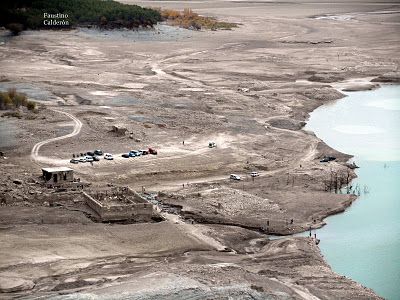
When significantly lower water levels, are the meager remnants of the spa. Today the place is frequented by visitors to make use of the remains of hot springs and mud-bathing.
Best regards.
Luis.
Sponsored by Costaluz Lawyers
(Click down here):
.jpg)
 0
Like
Published at 2:53 PM Comments (1)
0
Like
Published at 2:53 PM Comments (1)
The first time in Spain
Tuesday, August 7, 2012
For the first time in Spain, it has been placed a pacemaker to a baby through his veins.
The last July-30, Cardiovascular Surgeons at the Hospital Virgen de las Nieves of Granada have placed a pacemaker to a baby, a year and a half old, through an intravenous procedure, a technique common in adults but that has not been practiced in Spain under that age.
This has been explained to Efe by the Dr. Abdo Abdallah, head of the pioneering intervention practiced last week, along with another cardiovascular surgeon, Francisco Gomera.
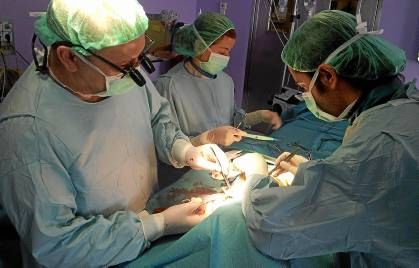
As he has pointed out, this technique had not been so far developed in Spain at such a young age under the difficulties to drive to the heart cables necessary for the pacemaker within a limited thick veins.
The patient, a male of 9.5 kilos, was born with congenital heart disease requiring surgical in the first months of life, when a pacemaker on the outer surface of the heart. However, over time it became necessary to implant a new device to give a more definitive solution to their health problems.
Although in such cases usually opt for open surgery to bring the electrodes directly to the heart, the multidisciplinary team in charge of the patient decided to implant the pacemaker through the veins of the child, by measuring this size and choosing the finer electrode in order to avoid breakage, explained yesterday Abdo Abdallah, cardiovascular surgeon who performed the surgery with Dr. Francisco Gomera in the hospital Virgen de las Nieves in Granada city (South of Spain).
The intervention not only be a little aggressive technique for the patient, enables lasting results compared with other surgical techniques.
The operation, which lasted for about 40 minutes, was "a success" and two days later the child was discharged, as the doctor was pleased Abdo Abdallah, who framed this in the joint work of hospital staff involved in the care of the child.
Meanwhile, the Chief of the Cardiovascular Hospital Virgen de las Nieves, Dr. Salvador Lopez Checa highlighted the fact you were able to perform this action, common among adults, a baby so little weight, which is, He explained that a "satisfaction" with the new roads that open in the healthcare field.
Cardiovascular Surgery Service of the Virgen de las Nieves Hospital of Granada has become a reference center in the last five years of pediatric cardiac pacing. In fact, just a year ago Dr. Abdallah also held the first pacemaker implant in a newborn of 1.500 g. on the first day of life, as part of an intervention also pioneering.
This type of surgery in children had not ever made in Spain, although in other countries like the United States.
Kind regards,
Luis
Sponsored by Costaluz Lawyers
(Click down here):
 0
Like
Published at 2:50 PM Comments (0)
0
Like
Published at 2:50 PM Comments (0)
Bioibérica: a good example of recycling animals in Spain
Monday, August 6, 2012
Bioibérica is a spanish company that recycles animals wastes --for example: belly of pork, beef tracheas and rooster combs.
The Director of the company, Daniel Mediavilla, explain that debris can become products of interest.For example: from the mucous membrane of the stomach of a pig is got the Heparin (a substance necesary for the blood clotting).
Bioibérica also works with gorges of cow; from them they get the Condroitin sulfato (a substance that serves for regenerate the cartilage and treat diseases such as osteoarthritis.
From the rooter combs are obtained the "Ácido hialurónico" --this substance is also obtained from the skin of the shrimps--; this ácido serves as a filler in surgery and dentistry.In this sense, Bioibérica is a company that wants to be the first company in the treatment of the osteoarthitis; it has a special interest in regenerate cartilage and its func- tion anesthetic.
The ability to take advantage of waste does not end here. "The performance we get from these products is very low and less than 2%," says Verges (Medical Director and scientific of Bioibérica). "So we do studies, we collaborate with the university, hospitals or other centers of R & D to give added value," he says. From one of these works in cooperation with the academic world, particularly with the chair of the lawn at Virginia Tech, developed an amino acid can make the grass grow faster. With this product, now marketed under the name of Terra-Sorb, paid about 4.000 of the more than 16.000 golf courses in the U.S. there. Also market-oriented agriculture and as a way to get more from the production of heparin is the CeraTrap, a liquid that attracts flies and is used to control pests of fruit flies.
One of the key work is the approach Bioibérica between the centers of knowledge creation such as universities and other public research organizations, and private environment where this knowledge finds its application. "This collaboration has changed for the better," says Verges. "Before working with the company was considered sinful, but I think from the academic world can work with the company honestly, clearly stating the conflict of interest," he adds. From one of these collaborations, in particular through the Chair Bioibérica Tissue Engineering and Cell Therapy with the University of A Coruña have developed a saliva test to predict whether the patient will develop osteoarthritis more or less rapidly.
Despite the economic situation, Bioibérica, like many companies that support their business in science and technology, can not stand bad the crisis. Contrary to what happens in many other companies in Spain, has grown in number of employees: 352 in 2009 to 386 in 2011. The same has happened with the billing: from 212.68 million in 2010 to 243 in 2011. Its 12.5% investment in R & D (the Spanish average of 0.72%), 65% of university staff and 32% of export-based business are some facts that may be the key growth.
If you want to take more information, about this theme or another one, you can visit the website: www.esmateria.com
Best regards,
Luis.
Sponsored by Costaluz Lawyers
(Click down here):
 0
Like
Published at 2:27 PM Comments (0)
0
Like
Published at 2:27 PM Comments (0)
Esco: one of the last inhabited villages in Spain
Saturday, August 4, 2012
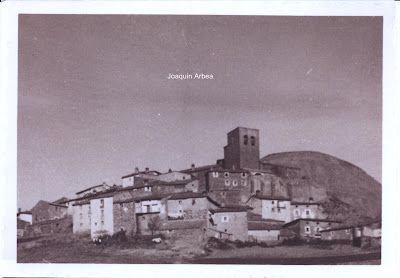
Esco, Aragon, North-West of Spain, in 1950.Picture courtesy of Joaquin Arbea.
Current Status: 3 people.
Altitude: 580 meters.
Distance in miles:
Sos del Rey Catholic: 39 km.
Zaragoza: 159 km.
Madrid: 411 km.
Access: Highway passes of the Pyrenees 400 meters from the village. A short walk of 5 minutes.
District: The Jacetania.
Thanks to Jose Luis Clemente extraordinary, president of the Association for the reconstruction of Esco, for their unconditional cooperation in preparing this article.
Thanks for everything, José Luis.
The third of the villages killed by the construction of the dam of Yesa was the beautiful village of Esco (the other two are Tiermas and Ruesta) was the smallest of the three, but was the only one who has never become completely depopulated. Of a house always comes out the chimney smoke in the cold days of winter, to teach all who pass hurriedly by the road, although Esco has been agonizing for many years, has never come to die, so least in regard to human presence.
We present the people of Esco in a half moon resting on a hill called Calvary. Made up of two districts (Upper and Lower), distributed its 60 houses in three streets (Low, Medium and High).
It had good farmland on the banks of the river Aragon (where now are the waters of the reservoir), devoted to crops were irrigated as beans, potatoes, cabbage, chard, tomatoes, etc.. being the furthest from the river land for dry farming (barley, wheat and oats in particular), while the hills situated above the town were for grazing sheep and to a lesser extent goats.
They were a people who enjoyed self-sufficiency, because of good products that tore the land and the quality of meat they raised, which was missing the swine, rabbits, chickens and pigeons, also was consumed lamb, they sold the people they had sheep and to a lesser extent beef that was more difficult to achieve. There was a house where they sold fish (Pellón house) and another where he was the village shop (home Tiopedro) and you could get a bit of everything in general, even the bread they made this house for sale, when people did not do their own bread in the ovens that were in each house.
From the 50's, cause of good communication bus that was on the road, flocked to Sangüesa fat to make purchases and provided plants for the gardens.
Also it had 2 bars, although in earlier times came to be four.
Counted with electric light in homes before the war, from a small plant that was in Tiermas. In the early 50's there was a flood that was the central front and had to return to the light of the carbides, until about the year 57 was a transformer to bring the light from Jaca.
It was not the case for water. There was a project to bring water to the edge of town, but whatever the people were sentenced was not carried forward. The water was brought in onganetas (wicker baskets), whether in horses or burros. In the houses had earthen jars of 150 l. and was stored there.
As basic services are concerned, there was resident priest in Esco until 1950 and thereafter was to Sigüés which came to officiate at religious services. There was also always master and teacher residing in the village, from the year 63 when they had few school-age children, the school was mixed and there were only teacher.
The postman also resided in the village, like the blacksmith.
The doctor came from Tiermas, just as the veterinarian, in recent years and the first came from Sigüés while the second made him from Salvatierra de Esca.
The festivities were held on the day of St. Michael (September 29), but it was busy time with the cattle were changed from date to the early twentieth century, becoming the 30th of November for San Andres.
Lively parties where the dance was missing was done in a salon of Casa Marcelo, well entertained by musicians from orchestras or by people from other nations, as were the musicians Lumbier.
There was no lack either the rounds, where the young men playing guitar and the mandolin sang jacks at the gates of the home and took viands they offered them (eggs, bacon, sausage, etc.). With working a dinner. The girls were doing chocolate for a snack and they used more revelers gather at dawn, and finish the dance, eat a few crumbs made at the time.
Each September 8, day of the Nativity of the Virgin, it had a habit of making a procession to the hermitage of the Virgen de las Viñas, distant about 800 meters from the village, the procession was repeated last day of the Ascension.
The amusements were those of that time in the little free time he had, the men went to take a sip of wine and play cards in bars, dancing boys and girls organized on Sunday, it resorted to Judas (Matias Figoli) who played the mandolin and violin playing Rebolé, along with some boy who played a little guitar and I had the orchestra. Each waiter brought what I could and it paid the musicians and they made a snack.
Despite the peaceful life of the people, the sword of Damocles hanging over Esco, since from 1930 and the project was underway to make the swamp, they warned residents not to perform home improvements that they are not would pay. Early in the 50's most fertile land expropriated, standing by the river, which the people took their main livelihood. In the law of eminent domain in 1953, included a clause which permitted the expropriation could ask to be expropriated other assets to draw some money to start over somewhere else, since the floodplain were not paid a price gold, which not only ran out of their way of life forever but also not getting enough money to start a new life elsewhere. They were encouraged to ask the city council the expropriation of the people, saying that if anyone wanted to return could do so whenever I wanted, but the reality was different, as you said José Luis Clemente:
'' In 1978 we request the reversal of the house with my grandfather and the resounding answer was NO because they say that the expropriation was voluntary. Later in 1998 I initiated a dispute against CHE and in 2006 the High Court of Justice of Aragon gave me negative response and the advice of counsel not resorted to the Supreme Court (if I had won the lottery, I really would still be litigating).
As always we have indicated the ban on entering the houses and then the frustration of not being able to do anything legal to keep.''
A traumatic decision for pelaos (nickname which was known to the inhabitants of Esco), having to leave behind a lifetime and some roots that would be left buried forever with the progress of the neighbors.
'' I often was telling my father why have not stood up. The answers were clear: In former times, had they would have opposed the Civil Guard sent to evict them, just did as they advised, also instilled in them they had to leave the village to give them a better life for their children, in terms this issue what is sacrificed father for her children? So the vast majority did what they said, acting in good faith, and opted out, people were marching in steps as could be done with other property besides that deceived them by telling them if anyone could return as soon repented wanted, which was not fulfilled.''
In the middle of the 60 had severely depleted the population, but even in 1965 there was a birth in Esco, as was that of Marisa Sanchez Canton House, which was the last born in the village.ecalls those years of uncertainty Jose Luis Clemente:
Also in 1965 there was an anecdote, as was the first car that was in Scotland, a Seat 850 owned by Mario Sanchez and Maria Momo Tiopedro House.
So things, people continued to live in Esco until the early 70's, mostly pelaos marched in Pamplona and Zaragoza, some families to San Sebastian, and some other Barbastro, Reus and Madrid.
Only Felix Guallar and his family chose to stay in town. As had sheep, which was their livelihood would not go, Felix was from Buyero House but left alone in the village chose to move to live in House Guallar, that brought together best. Felix died in 2010 but three of his children (Felix, Baltasar and Evaristo) have continued with cattle and continue to daily human presence on the streets of Esco.
The old neighbors and their descendants in some cases requested the reversal of the houses, which have not been made any case, which together with the rapid deterioration that were taking houses and heritage of the people, made to organize and 1999 created the Association for the reconstruction of Esco, getting rehabilitate the shrine of the Virgen de las Viñas which was in ruins, as well as the cemetery and look after the interests of the people, as it could be a recovery and reconstruction of buildings, as well as rescue and promote the customs and traditions that were in the village.
For all that have created a website with all the town's history, a blog, notebooks of all place names in Esco and published annually by the Herald of Esco (very interesting this publication) which account for all activities of the association, remnants of the town's history and all kinds of news that are related to the people.
The escotanos who have left and their descendants gather each year on May 1, where they celebrate a day of fellowship, make a Mass in the chapel, a picnic and other cultural activities and entertainment, all for you will not miss memory and the roots of Esco.
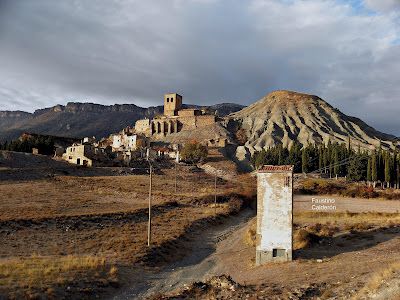
View of Esco from the road.
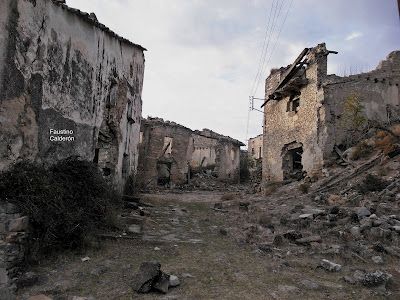
Entrance to Esco. Low Street.

House of Mariano Rita and House of Zamborán.At the end: House of Navarro.
.JPG)
From left to right: House The Teacher; thwy went to Pamplona, before 1960. House Blas of the Lessor;there lived the uncle Blas, who was alone; he died in 1964. House The American man; that was the only one house that had wc.House La Caminera or Aja; they went to Burlada (Navarra) at the begining of 60´.
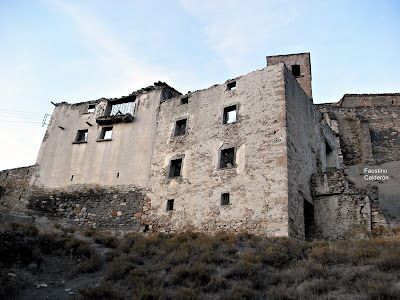
Middle street.House Orosieta; there lived the mother and her three sons; they were the last people who leaved Esco.To the right: House of Tiopedro; he had a shop and also he made bread, once in a week.The owners of this house had the first one car in Esco (a Seat 850).
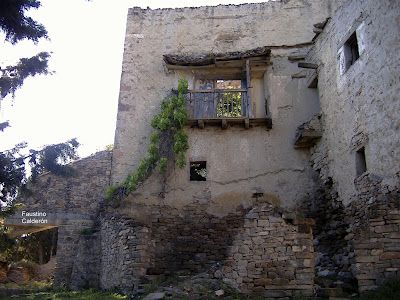
Low Street.House Lobera.In the 40´, this house was brought by the lady Ramona Mayayo and her husband.The last years, this house was habited by the family Orduña.

School of Esco.Down were the boys and up the girls.In the 60´, as there were only twelve students, the school became mixed.
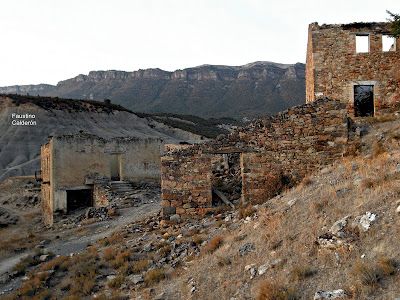
Low Street.House Lerrero, to the left; blacksmith house, in the middle; and the school to the right.
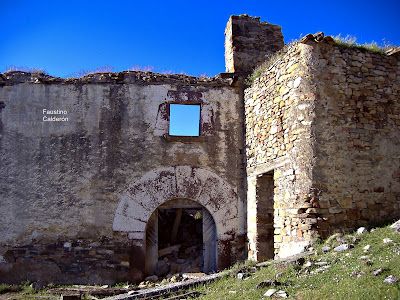
Middle Street.House Momó.It was a very big house.In it lived two brothers and one sister (Leopoldo, Alejandro and Rufina Odériz).On the arch of the main door, you can see a rosebush, in the Coat of arms.Moreover, there was another rosebush close the door.Then, when boys of the village went out as a round, they stopped outside the door and they sang one jot: "In the door of Momó, there is a rosera (it is a word similar than rosebush) very fine, you can not take the rose, without permission of Rufina".
.JPG)
Back of House Laguau.Here, there was a dance hall and a cinema.In the 60´, a man from Salvatierra de Esca projected a movie in the livingroom of this house; it was a great new in Esco.
.JPG)
Parish Church of San Miguel.
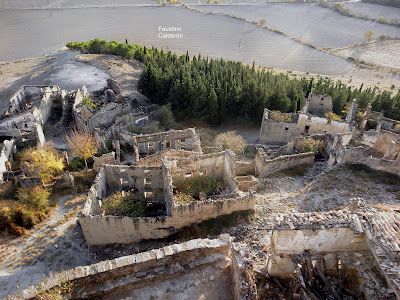
View of the slum, from the steeple of the church.
.JPG)
Slum.In the first term: House Torrea; they went to Pamplona.At the end: House Ventura.
.JPG)
Uptown.To the left: House Buyero; to the right: House the Teacher.
.jpg)
Family of House Buyero in 1956.
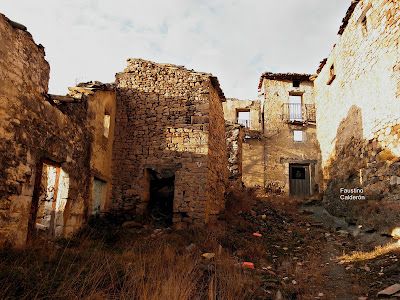
House Buyero, 56 years later.This is the same picture that the previous one.

High Street.House of the shearer.This man had two daughters and two sons: Aurelia, Santos, Agustina and Cecilio.Santos was the last Mayor in Esco.
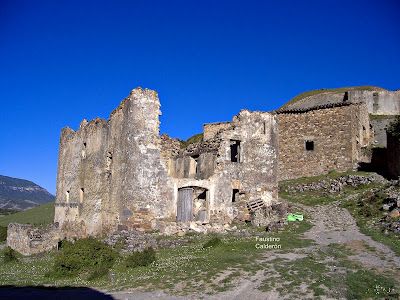
House Cantón.It was one of the last houses built, in Esco.
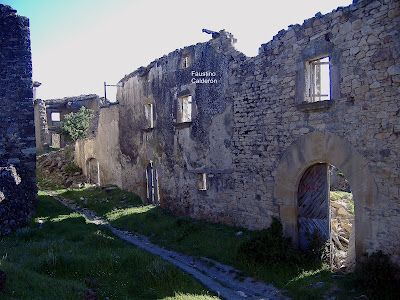
High Street.
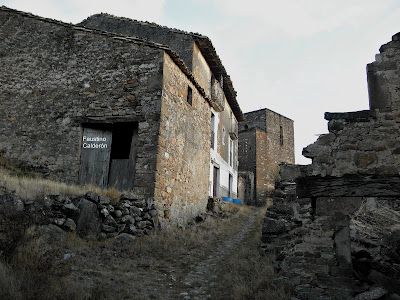
High Street.House Guallar.In the middle: the only one house that is habited.
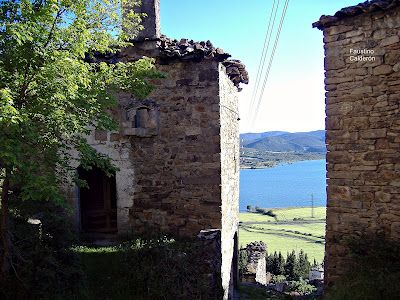
House the School.At the end: the swamp of Yesa.
I hope that you liked this report.
Kind regards,
Luis.
Sponsored by Costaluz Lawyers
(Click down here):
.jpg)
 0
Like
Published at 1:31 AM Comments (7)
0
Like
Published at 1:31 AM Comments (7)
Cadiz: cradle of the spanish Constitution
Friday, August 3, 2012
200 years ago, Cadiz was the only mainland city that had resisted the French invaders. In its buildings, deputies from Spain and Spanish America passed the First Constitution, the origin of the rights and duties of the Constitutions of both sides of the Atlantic.
Cadiz is the most American of the spanish cities.And the most colonial.And the most bright.And the most Atlantic.This year Cadiz celebrates the bicentennial of the enactment of the first Constitution, adopted on March 18, 1812, in the only one peninsular city that was not then occupied by the french invaders. Two hundred years later, the discussion of the liberal deputies have returned to the streets and squares of the old city.Those scenaries have opened their doors to welcome, this year, tens of social and cultural events, recall rights and duties contained in the first Constitution.
Cadiz has opened a cultural and tourist route in honor of that historic event. It runs through the old city, Inland Gate, between the Ocean and the Bay, by the eighteenth-century streets and squares that year reached nearly two hundred members welcome pro-ceding from Spain and Spanish America.
The center of that debate was the Oratory of St. Philip Neri, a symbolic place in the center heart of the old city, between Tower Tavira and the Square San Antonio.In it was sealed the Magna Letter and the deputies cheered his promulgación.The facade of the building is covered with marble tombstones in memory of the deputies inside from the twelve year and even seem to hear the echoes of those political sessions, which began on September 14, 1811 and ended September 14 - 1813.The books of the sessions collected 1.478 discussions, which took place inside the temple, elliptical, open six chapels and rebuilt after the Lisbon earthquake history 1755.The History tells that the Cortes of Cadiz were formed with only 95 deputies cause of the difficulties in transit through a country at war .. However, the efforts of the liberal deputies made the approval of La Pepa, was popularly known as the text, adopted the day of St. Joseph (March 19 ), will add 184 deputies that day.
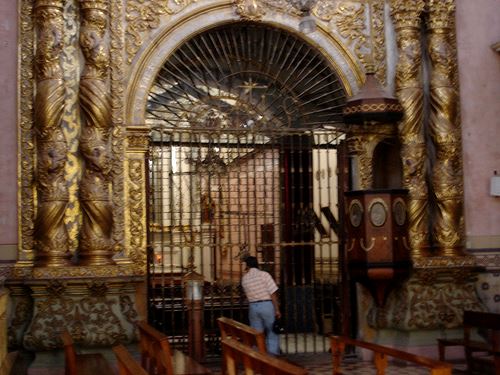
"Oratorio de San Felipe de Neri", Cádiz, South of Spain,by Christian y Sergio, at flickr.com
There are few places in the world that can boast a twin town.Cadiz has it across the Atlantic Ocean.It is The Havana, the capital of Cuba, to which it bears an amazing resemblance. Many of deputies arrived at the Spanish city, two hundred years ago, came from Hispanoamerica.Therefore, the Constitution of Cadiz was the starting point for the rest of constitutional texts, which were adopted across the world. Indian and colonial character that lives in every corner of Cadiz, which also boasts the oldest city in the West, with over three thousand years of history.
San Antonio is the aristocratic and bourgeois large square, square, sunny setting for games and meetings of heated political discussions for two hundred years, the gateway to a baroque church and a set of stately palaces, among which the Casino from Cadiz, the Aramburu´s house or the Peman`s house.The Square San Antonio derived Broad Street, which is an invitation to walk slowly, to snoop on the occupants of the old bookstores and convenience stores, businesses and nineteenth-century former headquarters of newspapers that were printed to be read here and there in Cadiz and in colonial America.
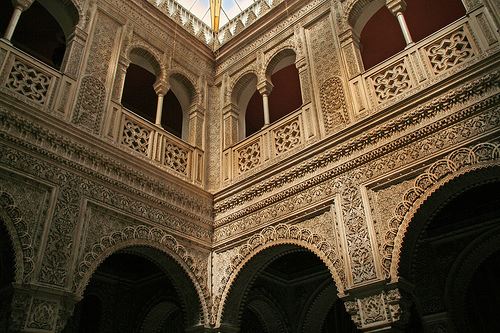
"Cádiz - patio neomudejar du casino de cadix, plaza de San Antonio", Cadiz, South of Spain, at flickr.com
Palaces such as the County Council also keep memory of those years and the monuments to the Cortes, in his sculptures reflect a bygone grandezas.Cádiz allegories also is a city of walls, bastions, malls and parks that still show the botanical catalogs brought the world.The New Walls of San Carlos, facing the bay, linking the Plaza of Spain with the Alameda Apodaca, and defenses for decades protected the city from the threat of French fleets, English and canyons topped holandesa.Aquellos today the corners of the blocks, like the paving of the streets were once stone ballast of ships.
There is a church registered with the constitutional route, dedicated to the Virgen del Carmen, where the texts say that it was sung the Te Deum in thanksgiving for the conclusion of the text magno.The voices of deputies are not listened, now that the traveler penetrates the solitude of his beautiful ships.But, there is in it, in its baroque altar, chapels flanking the Epistle and the Gospel, a sense that time has past and that Cadiz is anchored in those dazzling years everything was done and it seemed possible to achieve the dream.
Getting to Cadiz:
For the N-IV (Madrid-Cadiz), saving the Lion Bridge of Carranza.The AP-4 binds Seville and Cadiz.El nearest airport is Jerez de la Frontera.Los RENFE train travelers leave next Earth Gate, entrance to the walled city.
When to go to Cadiz:
Cadiz is a constant invitation, along the year.But in February held the famous Carnival of international interest in the performance of jokes, parades and coros.The grateful Spring is a time and summer is not as hot as in the Andalucia's interior.You have to be prevented the east winds, raging for days and during the ride uncomfortably.
Where to stay in Cadiz:
SOUTH PATAGONIA: Central, comfortable, modern and a bit bohemian burlon.It is one of the hotels most daring of Cadiz.
VICTORIA BEACH: Innovador.A building on the beach, with blue-glass terraces ..
ARGANTONIO: Small house of the SXIX, that mixes Andalusian art with architecture of the old houses in Cadiz.
Where to eat in Cadiz:
EL FARO DE CADIZ (THE LIGHTHOUSE OF CADIZ): Calle San Felix, 15.Es one of the best tables in the provincia.En he must taste the prawns from Sanlucar, Almadraba tuna and rice dishes.
CASA MANTECA (CHELSEA HOUSE): Street Corralón of cars, 1. Eating large hearth in the narrow streets of the typical neighborhood of Vine.
BALANDRO (SLOOP): Alameda Apodaca, 22.Situated in an unique place.Its kitchen mix-ing creativity and tradition.
Best regards,
Luis
Sponssored by:
Costaluz Lawyers
(Click down here):
 0
Like
Published at 5:35 AM Comments (0)
0
Like
Published at 5:35 AM Comments (0)
Spam post or Abuse? Please let us know
|
|